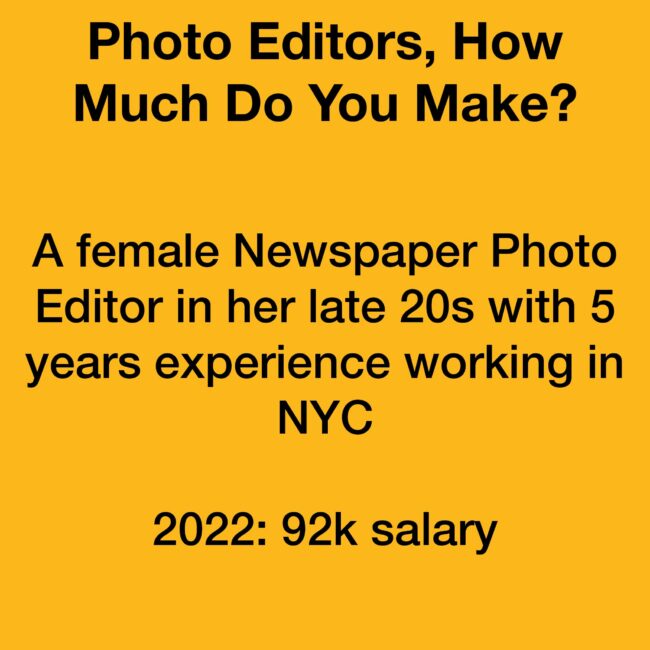I work for a major national newspaper in NYC.
I work full time job with 3-4 weeks PTO.
I started my current job in the low 80s, then received a few small bumps over the past couple of years to reach 92k.
I have no other sources of income this time, but would love to start a newsletter or offer 1:1 sessions with photographers who need editing help on personal projects, portfolio, or grant proposals.
For retirement I have a 401(k) with company match. I contribute 12% per year, with a company match up to about 3% which is not great, but it’s something.
I spend about a third of my day in meetings, talking with reporters, editors and other photo editors about upcoming coverage and how we should approach it visually. Another third of my day is commissioning and briefing photographers, and producing shoots for upcoming stories. The rest of my time is spent reading story drafts, researching and editing photos for quicker-turn stories, building online articles and collaborating with art directors on layouts for print. Also, processing invoices, tracking payment, sending contracts, onboarding vendors, all the admin stuff. It’s a lot.
There’s a slightly romantic view of photo editors from the outside, but some days our work feels so operational and further away from photography than a lot of us ever imagined. The pace, constantly shifting deadlines, newsroom bureaucracy, and aesthetic boundaries can be a bit crushing, but there are some really magical moments of creative collaboration.
There is no set path to break into photo editing, which can be incredibly opaque and frustrating. It took me years of networking to get a full-time gig. Some people enter the industry in more traditional ways, such as art schools or photojournalism programs, others break in through an industry mentor, internships, fellowships, lateral moves in a newsroom from other functions, or years of freelance photography.
While they are super competitive and few, photo editing internships are the most reliable way to establish the portfolio and skillset for a full-time editing job. It is certainly possible to develop your eye and learn the skill of editing, sequencing and visual narrative in a workshop or developing your or a friend’s personal project.
That being said, a truly effective Photo Editor is built making edits in minutes rather than hours, in hard conversations we have around ethical and accurate image making and selection, and constantly advocating for photography in newsrooms where words often come first. You must learn to articulate the value of an image to reporters, editors, etc. with limited visual vocabulary, and often make artistic compromises for the fit and betterment of a story. For the record, I find a lot of this very frustrating. I wish you didn’t need experience (and a whole lot of luck) to get experience. But it’s true.
Best advice: Surround yourself with photo and non-photo folks who support you, inspire you, and offer a safe place to brainstorm ideas freely without competition. This industry is very small, so be kind. Establish strict work-life boundaries. Have a hobby outside of photography, get outside, and take care of yourself.
Worst advice: Settling for the safe, easy option. Often times photo editors get a bit stagnant with commissioning and creative direction because the role is so demanding and they become too risk averse. But every story is an opportunity to push the industry and publication forward, from aesthetics to representation, even if it can be difficult internally sometimes. You have power, so use it productively. You will become a better creative professional learning to have these tough conversations respectfully and collaboratively.
I am never annoyed with emails or even DMs, Instagram is a major tool for me to find new talent and get inspired, plus engage with people in a way that isn’t super time consuming like an email can be. I can’t respond to every message, but I always read them, and will often give someone a follow if I see potential in their work. Getting DMs on the weekend or after work hours isn’t the best, but I’ve kinda accepted my fate there and try to keep my own boundaries because people are on different time zones and are busy too.
The most successful cold emails are highly specific, know what subject matter I cover, and include a pitch idea that is thoughtful, well-researched, and recognizes the need for some sort of hook and a visual narrative that can stand alone without a reported article. If we have an established relationship, I’m more open to looser pitches/ideas and will do more initial legwork to develop the pitch and get buy-in internally. I don’t expect you to be an expert in our coverage, but some awareness around that goes a long way!
One gripe, and I say this with so much love: please do not bcc a bunch of editors on one email–we can tell, and we all talk! I know- writing individual, tailored emails is very time consuming. But I think targeting a few specific editors you want to collaborate with, articulating why your work is a good fit for them and their publication, and focusing your email and meeting efforts there will drastically increase your success rate.
I find photographers through Instagram, agencies, lists like Diversify Photo and Women Photograph, art programs, portfolio reviews, bylines in other publications, other editor’s recommendations.
I pay $500 day rate plus expenses, multi-day assignments or longer term stories often result in a negotiated project fee.
